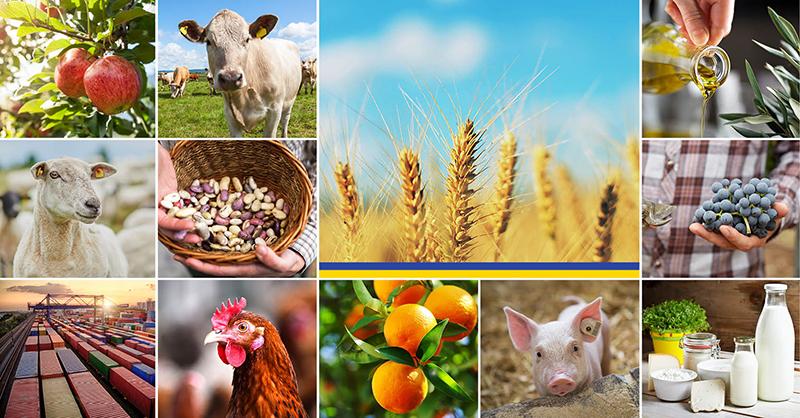
Russia’s military aggression against Ukraine has significantly disturbed global agricultural markets. This has created more uncertainty regarding the future availability of grains and oilseeds, and has added a layer of instability to already tense markets. The EU is largely self-sufficient for food, with a massive agri-food trade surplus, and the EU single market can once again be expected to prove its ability to absorb shocks. Nevertheless, there are some concerns around affordability due to high market prices and inflationary trends.
These issues form the basis for the spring 2022 edition of the short-term outlook report. Published by the European Commission on 5 April 2022, the report presents a detailed overview of the latest trends and prospects for a range of agri-food sectors.
Arable crops
Proposed measures to increase the EU’s arable crops production will allow farmers to increase their sowing area for maize, sunflowers and protein crops. As a result, the 2022 EU harvest may be a very good one for cereals and for oilseeds, provided normal weather conditions prevail. EU cereal production is projected to reach 297.7 million tonnes for the 2022 harvest. Together with a reduced demand for feed due to lower pigmeat production and reduced use of cereals for biofuel, this could help to soften the impact the expected lack of grain exports from Ukraine may have on global markets.
Exports of cereals are expected to increase by 14% this marketing year (until end of June), largely driven by an additional 5.6 million tonnes of soft wheat compared to the previous season. This may increase further after the 2022 summer harvest, with net exports of EU cereals potentially increasing by almost 40% to 41.4 million tonnes from July 2022 to June 2023 (2022/23 marketing year).
Oilseed prices have skyrocketed since the beginning of Russia’s invasion of Ukraine, with rapeseed and sunflower seed prices reaching EUR 1,000 per tonne. Oilseed production, however, is not a concern, being estimated to grow by 6.5% to 30.2 million tonnes this marketing year, and projected to increase to 32.2 million tonnes in the coming marketing year. The latter would include 11.2 million tonnes of sunflower seeds.
A sharp rebound in sugar beet production in France means that EU sugar production is expected to increase by 14% for 2021/22, to 16.6 million tonnes. An increase in consumption is anticipated but stocks are still expected to be higher at the end of the campaign.
Specialised crops
Olive oil production could reach 2.3 million tonnes in 2021/22, growing 10% year on year. An increase in input, packaging and transport costs, along with greater demand for olive oil to replace other vegetable oils currently experiencing price spikes, should keep prices high. This substitution for other vegetable oils could see a 7% increase in consumption. Increasing prices are likely to affect EU exports negatively, however, with a 3% reduction year on year.
Apple production remains high, at close to 12 million tonnes. A reduction in exports of fresh apples, together with high stocks, are resulting in an increase in the share of apples going into processing. While the pandemic had caused a positive consumption effect, this has now faded away.
The production of oranges for processing is expected to rise sharply, increasing by 30%. Meanwhile, the production of fresh oranges remains unchanged. Total orange production is due to grow by 4.4% to 6.6 million tonnes. EU imports and exports of processed oranges reached historically low levels, while per capita consumption of fresh oranges is also expected to decrease.
Milk and dairy products
The seasonal trend usually observed in the price of EU raw milk did not materialise in 2021, with the price instead increasing throughout the year. Despite this, milk deliveries fell by 0.4%, the first time this happened since 2009. Rising costs slowed down the growth of the milk yield and contributed to a stronger than expected reduction in the dairy herd of 1.5%.
Rising inflation and input costs are also likely to place more pressure on consumer prices for dairy products. While cheese and butter consumption may still increase slightly, the use of milk powders in processing is expected to decline.
Overall, the cheese and whey production stream could continue to be the preferred option, while some recovery in the production of skimmed milk powder is expected, likely supported by an increase of exports.
Meat products
Beef production is expected to decrease in 2022 despite high prices. This is mainly due to structural adjustments in the beef and dairy sector. Exports should increase slightly due to recently concluded trade agreements, but are constrained by limited domestic supply and trade frictions with the UK.
High costs and the lasting effects of African Swine Fever (ASF) mean that pigmeat production is expected to decrease in 2022, despite a strong increase in prices in recent weeks. Exports are also likely to decline due to ASF, despite a recovery in exports to the UK and improved market shares in some other destinations.
Poultry production is expected to increase slightly in 2022, with Avian Influenza (AI) still acting as a major limiting factor. High prices have compensated for high costs so far. Despite AI related trade restrictions and Russia’s military aggression against Ukraine, exports are still due to start recovering. Additional imports from the UK, Brazil, Thailand and China may replace imports from Ukraine.
A historically low EU sheep and goat flock is expected to result in a production decline of 2% in 2022. Trade will remain at relatively low levels, which is likely to lead to sustained high domestic prices. Trade frictions with the UK continue to cause uncertainty for both imports and exports.
More information
Details
- Publication date
- 5 April 2022
- Author
- Directorate-General for Agriculture and Rural Development
- Location
- Brussels
